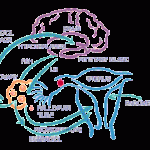
What is Amenorrhea?
Definitions:
What’s Normal?
The definition of amenorrhea is the absence of menstrual bleeding in a woman of reproductive age. When an adolescent experiences her first menstrual cycle, or her first menstrual bleeding, that is call menarche. Menarche is a part of puberty. The age at which menarche occurs can vary considerably given different variables such as a young teen’s diet, level of exercise, exposure to environmental estrogens, genetic factors, and etc.
Amenorrhea is normal during a healthy pregnancy. In some women (but not all), this lack of menstrual bleeding continues even after childbirth, if the mother regularly breast feeds her infant. Amenorrhea also occurs naturally in all healthy, older women during a stage of life called menopause.
What’s NOT Normal?
However, amenorrhea can also manifest as a symptom to signal that there is something wrong. First, some basic definitions:
Primary Amenorrhea: When an adolescent’s first menstrual bleeding, or menarche , doesn’t occur by the anticipated age, it’s called primary amenorrhea. There are various causes for this condition in a female, and can be properly diagnosed by a medical provider.
Secondary Amenorrhea: This is a cessation of menstrual flow (menses) that occurs sometime after menses has occurred. [Note: this does not include the months immediately following menarche when a young woman’s cycles tend to be irregular in cycle and inconsistent in flow.] The most common reason for menstrual cycles to stop is a hormonal imbalance within the endocrine system. The endocrine system a a very complex system and includes several organs such as the hypothalamus, pituitary, adrenal glands and ovaries (to mention just a few). Sometimes difficult to differentiate between other abnormal bleeding patterns, secondary amenorrhea can be acceptably defined as an absence of menstrual cycles for a period of 3 to 6 months.
Oligomenorrhea: This is an abnormal bleeding pattern which is defined as menstrual cycles occurring at intervals longer than 35 days.
Amenorrhea: Typically defined as no menstrual bleeding for a period of 3 to 6 months.
Normal Menstrual Cycle
For a normal menstrual cycle to occur, several organs of the endocrine system must  function in harmony together through the use of cellular communications orchestrated by hormones. If this orchestration proceeds successfully, an egg (follicle) will begin to growth within the ovary, while at the same time other hormones are stimulating the lining of the uterus to prepare for the anticipated arrival of an egg to embed (or implant) there. If the egg is not fertilized, hormones are released to communicate this message to organs of the endocrine system. When this occurs, the lining of the uterus (known as the endometrium) will slough off, and the woman will experience this as menstrual bleeding. Then the hormonal orchestra starts the process over again, like clockwork, typically every 26-30 days.
function in harmony together through the use of cellular communications orchestrated by hormones. If this orchestration proceeds successfully, an egg (follicle) will begin to growth within the ovary, while at the same time other hormones are stimulating the lining of the uterus to prepare for the anticipated arrival of an egg to embed (or implant) there. If the egg is not fertilized, hormones are released to communicate this message to organs of the endocrine system. When this occurs, the lining of the uterus (known as the endometrium) will slough off, and the woman will experience this as menstrual bleeding. Then the hormonal orchestra starts the process over again, like clockwork, typically every 26-30 days.
Three (3) Phases of a normal menstrual cycle
I’m not going to go into lengthy detail here, but the three phases of a menstrual cycle are:
First: Follicular Phase – This phase begins on the first day of bleeding of the menstrual cycle and goes till about day 14 of the cycle. Both the pituitary gland and the hypothalamus play an important part in the initiation of this phase. The two key hormones of this phase are, first the Follicle Stimulating Hormone (FSH) which stimulates follicles (oocytes, or eggs) to develop. Second, through a process of aromatization there is an increase in the level of estradiol (one of three different estrogens) within the ovaries which stimulate the follicles to mature. Only one follicle, or egg, reaches full maturity.
Second: Ovulatory Phase: Prior to the occurrence of ovulation, another hormone is being produced – the luteinizing hormone (LH). This luteinizing hormone (LH) works together with FSH, estradiol, and other hormones and specialized receptor cells in a very complex orchestration of cellular communications via hormones of the endocrine system. Their end goal is to stimulate the outer layers of the maturing follicle to produce progesterone. This process is very complex in design, requiring complex cellular communications to be both sent and received in order to produce and sustain hormone levels high enough to trigger ovulation. When everything does come together to create a terrific surge in LH and progesterone levels, a life-potentiating miracle occurs within the woman’s ovary. When ovulation occurs, it is usually on day 14, 15 or 16 of the menstrual cycle. Once the ovum is released from the follicle, the granulosa cells of the follicular lining increase in size and turn a yellowish color characteristic of lutein. This structure on the surface of the ovary is called the corpus luteum and produces several hormones, including progesterone.
Third: Luteal Phase: The last phase of the menstrual cycle is the luteal phase. As with the first two phases, there is a complex orchestration of cellular communications that occur through the release or inhibition of specific hormones. Which hormones are released depends largely on whether or not the egg becomes fertilized after ovulation. It’s important to understand that the main hormone of this phase is progesterone. During the luteal phase, progesterone is significantly higher than at any other time during a menstrual cycle. The corpus luteum is responsible for this high level of progesterone. If a woman becomes pregnant during this phase, progesterone levels will remain high in order to maintain the pregnancy. If, however, the egg is not fertilized, human Chorionic Gonadotropin (hCG, or the hormone of pregnancy) will not rise, and the lining of the uterus (endometrium) will slough off as menstrual bleeding occurs 14 days after ovulation.
Causes of Amenorrhea
For an adolesce nt to experience her first menstrual cycle (menarche), and then to fully develop into a young woman who experiences regular monthly menstrual cycles, normal functioing of the endocrine system is a prerequisite. The HPA axis is comprised of the Hypothalamus, the Pituitary, and the Adrenal Glands. For women, In addition to the main axis, the Ovaries also need to be physiologically healthy and functioning. If there is any disruption in the functioning of these endocrine organs, the result will be a hormonal imbalance which can result in amenorrhea. The level of dysfunction can vary drastically, depending on the pathophysiology of the medical condition.
nt to experience her first menstrual cycle (menarche), and then to fully develop into a young woman who experiences regular monthly menstrual cycles, normal functioing of the endocrine system is a prerequisite. The HPA axis is comprised of the Hypothalamus, the Pituitary, and the Adrenal Glands. For women, In addition to the main axis, the Ovaries also need to be physiologically healthy and functioning. If there is any disruption in the functioning of these endocrine organs, the result will be a hormonal imbalance which can result in amenorrhea. The level of dysfunction can vary drastically, depending on the pathophysiology of the medical condition.
Hormonal Birth Control: Some forms of active hormonal birth control can cause a complete cessation of menstrual cycling, such as an intramuscular injection of DepoProvera; and yet in other women who use the exact same treatment, DepoProvera has been documented to cause uncontrollable bleeding that lasts for months until the treatment duration is past and the synthetic progestins have finally been metabolized. It has also been reported by a significant proportion of women who have taken birth control pills, that even after they had stopped taking the pills, it took several months for their menstrual cycling to resume. And in other women, their menstrual cycles never did resume, as the hormonal birth control had induced a state of infertility. This form of amenorrhea can be avoided simply by avoiding treatments that have a risk of inducing a severe hormonal imbalance. [The hormonal effects of birth control are discussed in another article under Kathryn’s Notes.]
–malnutrition (i.e., anorexia): if there are not enough available nutrients for normal cellular function throughout the tissues and organs of a female’s body, energy (from calories ingested) will be diverted away from body systems that aren’t specifically required to maintain life, i.e., the reproductive function. When this happens, a woman will stop having menstrual cycles. This is a very serious medical condition that needs immediate attention. When I was a young teenager, one of my favorite female vocalists was Karen Carpenter. She had such a melodic, rich voice. Sadly, she fell victim to engaging in anorexic practices, and as her body was forced to metabolize its own organs, she died at the age of 32 from heart failure.
–emotional stress or upset
–brain injury
–tumor in the brain or other endocrine organs that secrete hormones affecting menstruation (i.e. pituitary gland, ovaries or adrenal glands)
–thyroid problems
–depression
–vigorous exercise (women who run marathons can experience amenorrhea)
–some prescriptions medications such as anti-depressants and/or tranquilizers
–either a rapid weight loss, or a rapid weight gain can cause amenorrhea
–chronic illnesses such as colitis, cystic fibrosis or kidney failure
–chemotherapy or radiation therapy
–uterine infection or certain medical procedures such as a D&C (dilation and curettage) can cause “Asherman’s syndrome” which is a scarring of the endometrial lining of the uterus. The D&C procedure is routinely performed today for any woman who has had a miscarriage, unless she refuses to undergo the procedure. Medical intentions for the current standard of care are to reduce the risk complications of incomplete miscarriage. The D&C procedure is also performed routinely on women complaining of heavy bleeding during their cycle
–cigarette smoking has been known to cause amenorrhea
If you would like to Check Your Hormone Levels, or the hormone levels of a loved one, click here to be redirected to my website of Medical Lab Test Kits. These sample collection kits can be completed in the privacy of your own home. If you feel like you would benefit from a consultation with me, so that I can help you determine which test kit is best for you, given your current medical concerns, use our Contact Page for a phone number you can call, or send an Email.



Leave A Reply (No comments so far)
The comments are closed.
No comments yet